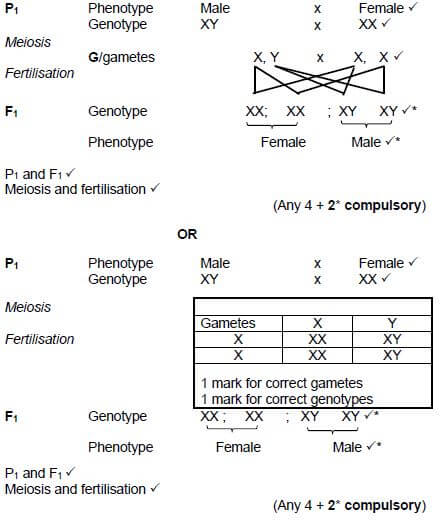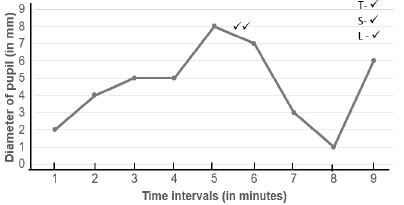LIFE SCIENCES GRADE 12 MEMORANDUM - NSC EXAMS PAST PAPERS AND MEMOS JUNE 2019
Share via Whatsapp Join our WhatsApp Group Join our Telegram GroupLIFE SCIENCES
GRADE 12
NSC EXAMS
PAST PAPERS AND MEMOS JUNE 2019
PRINCIPLES RELATED TO MARKING LIFE SCIENCES
- If more information than marks allocated is given.
Stop marking when maximum marks is reached and put a wavy line and ‘max’ in the right-hand margin. - If, for example, three reasons are required and five are given. Mark the first three irrespective of whether all or some are correct/ incorrect.
- If whole process is given when only a part of it is required. Read all and credit the relevant part.
- If comparisons are asked for, and descriptions are given. Accept if the differences/similarities are clear.
- If tabulation is required but paragraphs are given.
Candidates will lose marks for not tabulating. - If diagrams are given with annotations when descriptions are required. Candidates will lose marks.
- If flow charts are given instead of descriptions.
Candidates will lose marks. - If sequence is muddled and links do not make sense. Where sequence and links are correct, credit. Where sequence and links are incorrect, do not credit. If sequence and links become correct again, resume credit.
- Non-recognised abbreviations.
Accept if first defined in answer. If not defined, do not credit the unrecognised abbreviation, but credit the rest of the answer if correct. - Wrong numbering.
If answer fits into the correct sequence of questions, but the wrong number is given, it is acceptable. - If language used changes the intended meaning.
Do not accept. - Spelling errors.
If recognisable, accept the answer, provided it does not mean something else in Life Sciences or if it is out of context. - If common names are given in terminology.
Accept, provided it was accepted at the national memo discussion meeting. - If only the letter is asked for, but only the name is given (and vice versa).
Do not credit. - If units are not given in measurements.
Candidates will lose marks. Marking guideline will allocate marks for units separately. - Be sensitive to the sense of an answer, which may be stated in a different way.
- Caption
All illustrations (diagrams, graphs, tables, etc.) must have a caption. - Code-switching of official languages (terms and concepts) A single word or two that appear(s) in any official language other than the learners' assessment language used to the greatest extent in his/her answers should be credited, if it is correct. A marker that is proficient in the relevant official language should be consulted. This is applicable to all official languages.
MEMORANDUM
SECTION A
QUESTION 1
1.1
1.1.1 D ✓✓
1.1.2 D ✓✓
1.1.3 C ✓✓
1.1.4 B ✓✓
1.1.5 D ✓✓
1.1.6 A ✓✓
1.1.7 C ✓✓
1.1.8 D ✓✓
1.1.9 A ✓✓ (9 x 2) (18)
1.2
1.2.1 Ribosome ✓
1.2.2 Gene ✓
1.2.3 Mutation ✓
1.2.4 Heterozygous ✓
1.2.5 Reflex action ✓
1.2.6 Conjunctiva ✓
1.2.7 Multiple sclerosis ✓ (7 x 1) (7)
1.3
1.3.1 B only ✓✓
1.3.2 None ✓✓
1.3.3 A only ✓✓ (3 x 2) (6)
1.4
1.4.1
- Deoxyribose ✓ (1)
- Phosphate ✓ group (1)
- Hydrogen bond ✓ (1)
- Nucleotide ✓ (1)
1.4.2 Cytosine ✓/C (1)
1.5.1
- PpHh ✓✓ (2)
- green ✓ and smooth ✓ stem (2)
- ppHh ✓ (1)
1.5.2 25 ✓% (1)
1.5.3 ph ✓, PH ✓ (2)
1.6 1.6.1
- C ✓ (1)
- A ✓ (1)
1.6.2 By the corpus callosum ✓ (1)
1.6.3 The brain is protected from injury by:
- the skull, ✓
- meninges ✓ and
- cerebrospinal fluid ✓
(Mark first ONE only) (Any 1) (1)
1.6.4 The nervous system is needed to:
- detect changes ✓ in the environment (external and internal) and
- to react ✓ to these changes as well as
- coordinating ✓ the various activities of the body.
(Mark first TWO only) (Any 2) (2)
TOTAL SECTION A: 50
SECTION B
QUESTION 2
2.1
2.1.1 1 January to 5 January ✓ (1)
2.1.2 14 January ✓ (1)
2.1.3 Oestrogen ✓ and progesterone ✓ (2)
2.1.4
- Ovulation occurs when hormone 1 (oestrogen) is rising ✓✓/ near its peak (2) OR
- (Hormone 1) Oestrogen encourages/stimulates ovulation ✓✓
2.1.5
- Due to a decrease in the level of hormone 2 ✓ /progesterone
- The lining breaks down ✓/will be shed from the body (2)
2.2
2.2.1 Sexual reproduction ✓ (1)
2.2.2
- Internal fertilisation ✓ (1)
- Female eggs are deposited into the male pouch and fertilised inside the pouch ✓ (1)
2.2.3
- The fertilised eggs / embryo are nourished by the thickened skin inside the pouch ✓/ are not fed by the placenta as in humans
- until they are ready to hatch into live young. ✓ (2)
2.3
2.3.1 tRNA ✓/transfer RNA (1)
2.3.2
- During translation ✔
- the anticodon on the tRNA✔/ molecule X
- matches the codon on the mRNA ✔
- bringing the required amino acid ✔
- to the ribosome. ✔
- Amino acids become attached by peptide bonds ✔
- to form the polypeptide ✔preproinsulin (Any 5) (5)
2.3.3
- CAG ✓ (1)
- UUG ✓ (1)
2.3.4
- Mutation occurred in 6th codon ✔coding for leucine
- A was replaced with U ✔/ UUA changed to UUU
- resulting in the amino acid phenylalanine ✔ being picked up. (3)
2.4
2.4.1
- 2 ✓ (1)
- 11 ✓ (1)
2.4.2
- Male without Huntington’s disease ✓ (1)
- Hh ✓ (1)
2.4.3  (6)
(6)
2.5.1
- Meiosis I ✓ (1)
-
- Chromosomes are arranged in homologous pairs at the equator ✓
- crossing over is taking place. ✓ (Any 1) (1)
2.5.2 1- Chromosome ✓ 2- Centromere ✓ (2)
2.5.3 C, E, B, A, D ✓✓ (NOTE: correct sequence) (2) [40]
QUESTION 3
3.1
3.1.1 IA ✓, IB ✓, i ✓ (3)
3.1.2 2 ✓ (1)
3.1.3
- A child inherits one allele ✓ for each gene
- from each of the parents ✓ (2)
3.1.4
- In any fertilisation between two parents ✓
- who are heterozygous for blood group A and blood group B ✓
- there is a 25% chance of their children having blood group A, B, AB or O ✓/ their future children can have any one of the four blood groups (A, B, AB and O). (3)
3.2
3.2.1 Pupillary mechanism ✓ (1)
3.2.2
- Distance of the light bulb ✓ from the eye (1)
- Diameter of the pupil ✓ (1)
3.2.3 Diameter of the pupil exposed to varying distances of dim light in one-minute time intervals
Criteria for assessing the graph: Mark (6)
Type: Line graph drawn (T) | 1 |
Title of graph | 1 |
Correct:
| 1 |
Correct:
| 1 |
Plotting of points | 1–1 to 8 points plotted correctly |
3.2.4 Between 6 and 7 minutes ✓ (1)
3.2.5
- Since measurements were not all done at different distances ✓
- the light source was at the same distance ✓ from the person’s eye. (2)
3.2.6
- Time intervals were the same ✓/ one-minute time intervals
- Same time period of exposure to light ✓/ 10 seconds
(Mark first ONE only) (Any 1) (1)
3.2.7
- Only one person was used in this investigation ✓/ small sample size used
- The investigation was only done once ✓/ not repeated (2)
3.3
- Stem cells are non-specialised cells ✓that have the ability to develop into any type cell in the body. ✓ (2)
-
- embryo ✓
- umbilical cord ✓
- bone marrow ✓
(Mark first THREE only) (3)
-
- Can be used to treat a variety of human diseases ✓/ examples Alzheimer’s and Parkinson’s disease, diabetes, spinal cord injury, heart disease, stroke, arthritis, cancer and burns.
- Generation of new tissues ✓
- Stem cells could also be used to understand why some cells develop abnormally and lead to medical problems ✓
- Stem cells may be useful in the testing and development of drugs ✓ (Any 3) (3)
3.4.1 1
- Semi-circular canals ✓ 2
- Cochlea ✓ (2)
3.4.2
- It increases the surface area✓of the inner ear/ saves space
- thereby helping to boost low frequency sounds ✓/ allowing soft sounds to be heard (2)
3.4.3
- A change in speed/direction of movement ✓
- stimulates the cristae ✓
- in the semi-circular canals ✓
- The stimulus is converted to an impulse ✓
- The impulse is transmitted to the cerebellum ✓
- via the auditory nerve ✓
- The cerebellum sends impulses to the muscles to restore balance ✓ (Any 4) (4) [40]
TOTAL SECTION B: 80
SECTION C
QUESTION 4
- The process by which gametes are formed is called gametogenesis ✔ (1)
Spermatogenesis:
- Male gametes are formed by spermatogenesis ✔
- under the influence of testosterone ✔
- Diploid cells in the seminiferous tubules of testes ✔
- undergo meiosis ✔
- to form haploid sperm cells ✔ (Max. 4) (4)
Oogenesis
- Female gametes are formed by oogenesis ✔
- Under the influence of FSH ✔
- diploid cells in the ovary ✔
- undergo mitosis ✔
- to form numerous follicles ✔
- One cell inside the follicle enlarges ✔ and
- undergoes meiosis ✔
- Of the four cells that are produced, only one survives ✔
- to form a mature haploid ovum ✔ (Max. 7) (7)
Development of the zygote from fertilisation to implantation
- The zygote divides by mitosis ✔ numerous times
- to form an embryo ✔
- The embryo develops into a ball of cells ✔
- called the morula ✔
- which then develops into a hollow ball of cells ✔
- called the blastula ✔/blastocyst.
- It embeds itself into the uterus lining ✔/endometrium (Max. 5) (5)
Assessing the presentation of the essay
Criterion | Relevance (R) | Logical sequence (L) | Comprehensive (C) |
Generally | All information provided is relevant to the topic. | Ideas are arranged in a logical/cause-effect sequence. | All aspects required by the essay have been sufficiently addressed. |
In this essay | Only information relevant to the description of spermatogenesis and oogenesis and the development of the embryo from fertilisation until implantation is given. There is no irrelevant information. | All the information regarding the spermatogenesis and oogenesis and the development of the embryo from fertilisation until implantation is given in a logical manner. | At least:
|
Mark | 1 | 1 | 1 |
Content: (17)
Synthesis: (3)
TOTAL SECTION C: 20
GRAND TOTAL: 150